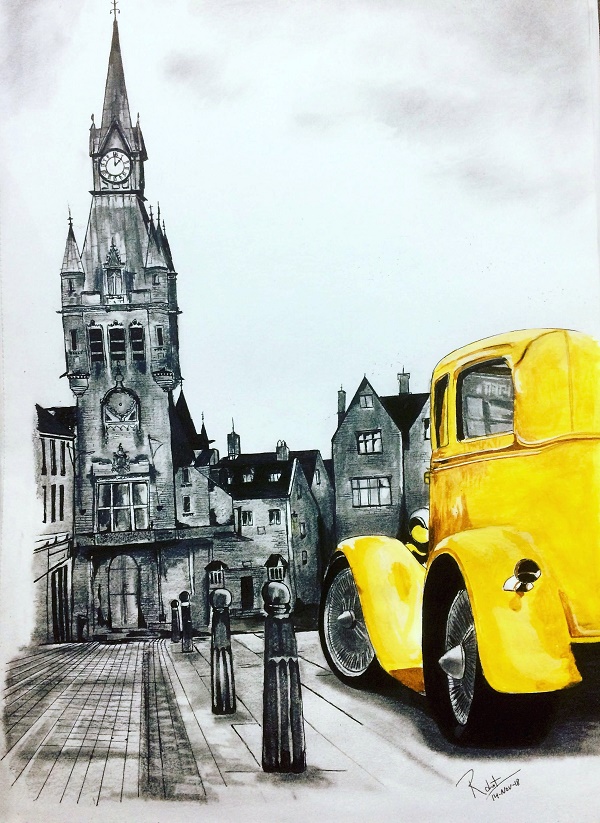People all throughout the world have traditionally used art as a means of expression. Through this avenue, people may express their feelings, ideas, and thoughts in a visual way. In the realm of painting, charcoal is one of the most adaptable and classic materials.
For generations, charcoal has been utilized as a medium. It is a kind of carbon that is produced from the low-oxygen combustion of organic materials like wood, bones, or shells. The finished product is then powdered down to a fine consistency and utilized to make art.
One kind of art made with this material is charcoal paintings. They are renowned for their grainy, smokey appearance, which gives them a distinctive and dramatic aspect. This blog will examine the development of charcoal paintings, the methods needed to produce them, and how sketch art enhances this classic medium.
The History of Charcoal Paintings
Since the dawn of human existence, charcoal has been employed in artistic creations. Charcoal was a common art medium among the ancient Egyptians, Greeks, and Romans. However, the Renaissance is when charcoal paintings really started to catch on.
During this time, charcoal was commonly employed by artists to make sketches that served as the basis for their paintings. These sketches were used to plan out the final painting’s perspective, lighting, and composition. Additionally, because charcoal allowed artists to more accurately depict the shape and motion of the human body than other media could, they were employed to produce studies of the human body.
Leonardo da Vinci was one of the most well-known painters to work with charcoal at this time. Some of his most well-known works, including the “Mona Lisa” and the “Vitruvian Man,” were produced with charcoal. His use of charcoal aided in bringing the art world’s regard for the medium to a new level.
Charcoal paintings grew in popularity during the 19th and 20th centuries. In order to produce a broad variety of styles and effects, artists started experimenting with the medium. Charcoal was employed to produce lifelike portraits, gloomy landscapes, and dramatic still lifes.
Charcoal paintings are still a favorite among both artists and art aficionados today. They may be utilized to produce a broad variety of effects and styles since they are flexible materials.
Techniques Used to Create Charcoal Paintings
A certain set of abilities and methods are needed to create a charcoal painting. The correct kind of charcoal must be chosen initially. Vine charcoal, compressed charcoal, and charcoal pencils are just a few of the several varieties of accessible charcoal.
The most common kind of charcoal used in charcoal paintings is vine charcoal. It is created from burned grape vines and is a soft, flaky charcoal. Vine charcoal is excellent for achieving seamless, delicate transitions in a drawing since it is simple to mix and erase.
A harder, more intense variety of charcoal is compressed charcoal. In order to create it, charcoal powder is compressed into sticks or pencils. The best material for drawing strong, black lines and shadows is compressed charcoal.
In the area of charcoal painting, charcoal pencils are a relatively recent development. While they resemble conventional pencils, they are packed with charcoal rather than graphite. For sketching delicate details and exact lines, charcoal pencils are the best choice.
Once the artist has selected the appropriate charcoal, they may start sketching. In order to allow the charcoal to stick to the surface and provide a distinct texture, charcoal paintings are frequently made on textured paper or canvas.
Blending is one of the most crucial methods used in charcoal paintings. In order to soften the edges of the charcoal and produce a seamless transition between bright and dark regions, blending is the process of utilizing a tool, such as a finger or blending stump.
Sketch Art: Complementing Charcoal Paintings
A different kind of artwork that is frequently combined with charcoal paintings is sketch art. Sketch art is a style of drawing that is swiftly and simply executed. The spirit of a topic, rather than its precise characteristics, is frequently captured in sketches.
Because a sketch enables the artist to swiftly capture a subject’s essential form and contour, it is the ideal companion to charcoal paintings. When doing drafts for a charcoal painting, this might be extremely helpful.
You may produce independent pieces of art with sketch art as well. A variety of materials, such as pencil, ink, and charcoal, can be used to produce sketches. In addition to paper, canvas, and even walls, they may be produced on a number of media.
Sketch art offers the artist the chance to experiment with many styles and methods, which is one of its advantages. Sketches may be produced fast and with no pressure, which enables the artist to test out novel concepts and techniques.
Another excellent technique to build a portfolio or body of work is through sketch art. An artist can explore many ideas and subjects, hone their abilities, and find their own unique style by producing a number of drawings.
Interesting Blog: Know Some Fun and Creative Uses Of Bulk Crayola Crayons
Conclusion
Sketch art and charcoal paintings are two traditional and expressive materials that have been utilized by artists for ages. Using a variety of methods, such as mixing, erasing, and hatching, charcoal paintings are noted for their smoky, textured look.
Sketch art is a style of drawing that is swiftly and simply executed. It is a fantastic compliment to charcoal paintings and may be used to make stand-alone pieces of art or as preliminary sketches for a charcoal painting.
Artists have a broad range of options for creative expression when using sketch art and charcoal paintings together. They provide artists the freedom to explore various aesthetics and methods while also using images to express their feelings, ideas, and thoughts.

